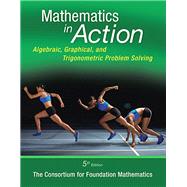In Mathematics in Action series, students discover mathematical concepts through activities and applications that demonstrate how math applies to their everyday lives. Different from most math books, this series teaches through activities—encouraging students to learn by constructing, reflecting on, and applying the mathematical concepts. The user-friendly approach instills confidence in even the most reticent math students and shows them how to interpret data algebraically, numerically, symbolically, and graphically. The active style develops mathematical literacy and critical thinking skills. Updated examples, brand-new exercises, and a clearer presentation make the Fifth Edition of this text more relevant than ever to today’s students.
Note: You are purchasing a standalone product; MyMathLab does not come packaged with this content. MyMathLab is not a self-paced technology and should only be purchased when required by an instructor. If you would like to purchase both the physical text and MyMathLab, search for:
0134134427 / 9780134134420 Mathematics in Action: Algebraic, Graphical, and Trigonometric Problem Solving Plus NEW MyMathLab -- Access Card Package
Package consists of:
0321431308 / 9780321431301 MyMathLab -- Glue-in Access Card
0321654064 / 9780321654069 MyMathLab Inside Star Sticker
0321969928 / 9780321969927 Mathematics in Action: Algebraic, Graphical, and Trigonometric Problem Solving
Students, if interested in purchasing this title with MyMathLab, ask your instructor for the correct package ISBN and Course ID. Instructors, contact your Pearson representative for more information.








